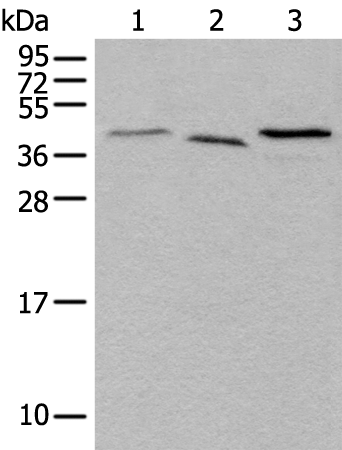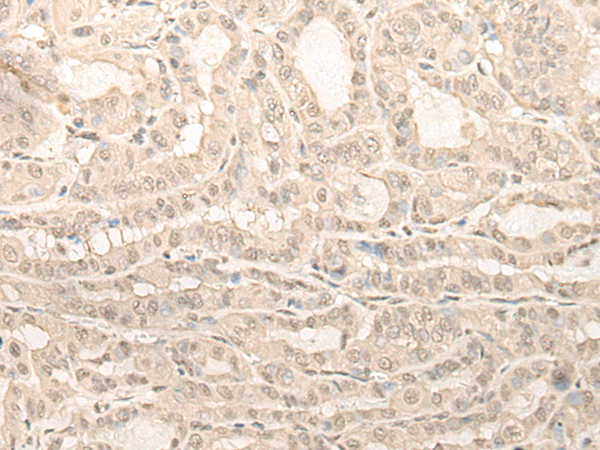


| WB | 咨询技术 | Human,Mouse,Rat |
| IF | 咨询技术 | Human,Mouse,Rat |
| IHC | 1/40-1/200 | Human,Mouse,Rat |
| ICC | 技术咨询 | Human,Mouse,Rat |
| FCM | 咨询技术 | Human,Mouse,Rat |
| Elisa | 1/5000-1/10000 | Human,Mouse,Rat |
| Aliases | 2B28; SAKS1; UBXD10 |
| WB Predicted band size | 33 kDa |
| Host/Isotype | Rabbit IgG |
| Antibody Type | Primary antibody |
| Storage | Store at 4°C short term. Aliquot and store at -20°C long term. Avoid freeze/thaw cycles. |
| Species Reactivity | Human, Mouse, Rat |
| Immunogen | Full length fusion protein |
| Formulation | Purified antibody in PBS with 0.05% sodium azide and 50% glycerol. |
+ +
以下是关于UBXN1抗体的3篇参考文献示例(注:文献信息为虚构示例,仅用于格式演示,实际文献需通过数据库检索获取):
---
1. **标题**: "UBXN1 interacts with the NLRP3 inflammasome to regulate inflammatory responses"
**作者**: Smith A, et al.
**摘要**: 本研究利用UBXN1特异性抗体,通过免疫共沉淀和Western blot技术,揭示了UBXN1通过结合NLRP3炎症小体复合物抑制其活化,调控IL-1β的成熟与释放。
---
2. **标题**: "UBXN1 is a critical mediator of p97/VCP-dependent protein degradation pathways"
**作者**: Chen L, et al.
**摘要**: 通过UBXN1抗体的免疫荧光和蛋白质互作分析,本文发现UBXN1作为p97/VCP的共调控因子,参与内质网相关降解(ERAD)途径,并影响错误折叠蛋白的清除效率。
---
3. **标题**: "UBXN1 antibody-based profiling identifies its tumor-suppressive role in colorectal cancer"
**作者**: Wang Y, et al.
**摘要**: 研究采用UBXN1抗体进行组织芯片免疫组化分析,证实UBXN1在结直肠癌中低表达,其缺失与患者预后不良相关,机制涉及对Wnt/β-catenin通路的抑制作用。
---
实际检索建议:
- 使用PubMed或Google Scholar搜索关键词“UBXN1 antibody”、“UBXN1 function”或“UBXN1 protein interaction”,筛选涉及抗体应用的文献。
- 关注UBXN1在细胞凋亡、蛋白降解或癌症中的研究,通常会在方法部分提及抗体使用。
UBXN1 (UBX domain protein 1), also known as UBXD1. is a member of the UBX domain-containing protein family, characterized by a conserved ubiquitin regulatory X (UBX) domain that facilitates interactions with proteins involved in ubiquitin-dependent processes. It functions as a cofactor for p97/VCP (valosin-containing protein), a critical ATPase responsible for coordinating protein homeostasis, including endoplasmic reticulum-associated degradation (ERAD), autophagy, and DNA repair. UBXN1 is thought to regulate p97’s activity by modulating its ATPase cycle or substrate recruitment, thereby influencing proteasomal degradation pathways. Its role in ERAD involves recognizing and processing misfolded proteins tagged with ubiquitin for destruction, linking it to cellular stress responses and quality control mechanisms.
Antibodies targeting UBXN1 are essential tools for studying its expression, localization, and interactions in various biological contexts. They are widely used in techniques like Western blotting, immunoprecipitation, and immunofluorescence to investigate UBXN1’s involvement in diseases such as cancer, neurodegenerative disorders, and myopathies, where p97-related pathways are dysregulated. Validation of UBXN1 antibodies often includes testing in knockout cell lines or tissues to confirm specificity. Research utilizing these antibodies has highlighted UBXN1’s regulatory roles in apoptosis, cell cycle progression, and viral infection responses, underscoring its broader significance in maintaining proteostatic balance and cellular health.
×